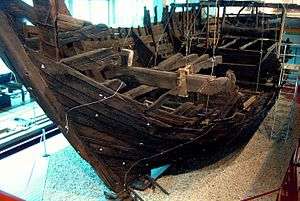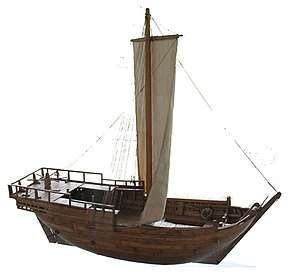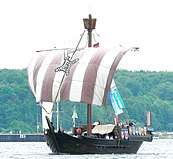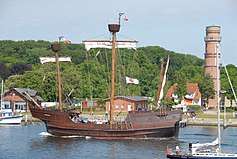Bremen cog
The Bremen cog or Bremer Kogge is a well-preserved wreck of a cog dated to 1380, found in 1962 in Bremen. Today, it is displayed at the German Maritime Museum in Bremerhaven as one of the main features. Three nearly identical replicas of this cog have been built: Ubena von Bremen, Hansekogge, and Roland von Bremen.
 The Bremen Cog at German Maritime Museum, 2002 | |
| History | |
|---|---|
| Laid down: | 1380s |
| Fate: | Sank while under construction, salvaged between 1962 and 1965, currently a museum ship |
| General characteristics | |
| Class and type: | cog |
| Tonnage: | 90 tons |
| Displacement: | 55 tons |
| Length: | 23.27 m |
| Beam: | 7.62 m |
| Sail plan: | Square-rigged |
| Notes: | Dimensions taken from exhibition notes at the Hanseatic Museum in Bergen |

The discovery
On 8 October 1962, wooden fragments of a ship were found in the Weser River during dredging operations. They turned out to be remnants of a cog that seems to have sunk during a storm flood after drifting away from a shipyard before completion. Until then, cogs had only been known from medieval documents and seals. Based on the dendrochronological analysis of the oak timber from which the cog was built, the ship was dated to about 1380 AD.
Salvage and reconstruction
The large parts were measured, registered, and stored in water basins in a pier shed in Bremen to prevent the wood from drying and shrinking. A further search with the aid of a diving bell ship in 1965 retrieved more than 2000 additional parts, which also were stored. It was decided to exhibit it in the planned German Maritime Museum in Bremerhaven. In 1972, the Koggehalle had been completed and the parts were reassembled under constant sprinkling. Almost the complete starboard side and a third of the port side could be reconstructed. The construction then was encased in a tank to be impregnated in polyethylene glycol for 18 years. Finally, it was cleared from the remnants and has been on display since 2000, 25 years after the opening of the museum.
The Bremer cog had one mast and was square-rigged, with a carvel-built bottom and clinch-built sides. The rib timber was built in after the hull had been made.[1] The cog was 24 m long, 8 m in the beam, and just over 4 m high on the sides. These measurements would have produced an estimated load capacity of 130 tons.[2] Other estimates put the cargo capacity at only 90 tons.[1]
See also
References
- Exhibition notes, Hanseatic Museum in Bergen (2014)
- Susan Rose, The Medieval Sea, (2007)

